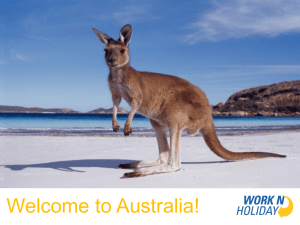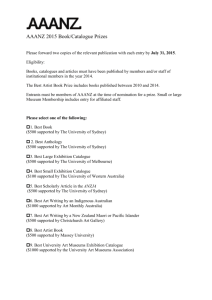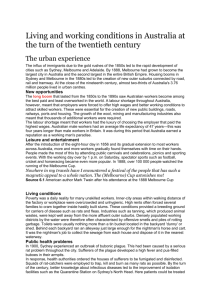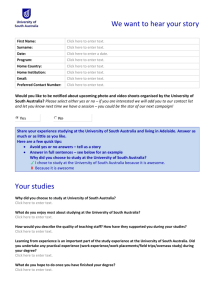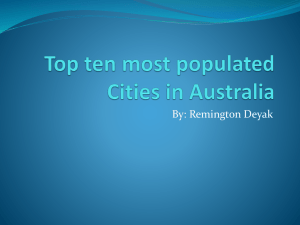msword
advertisement
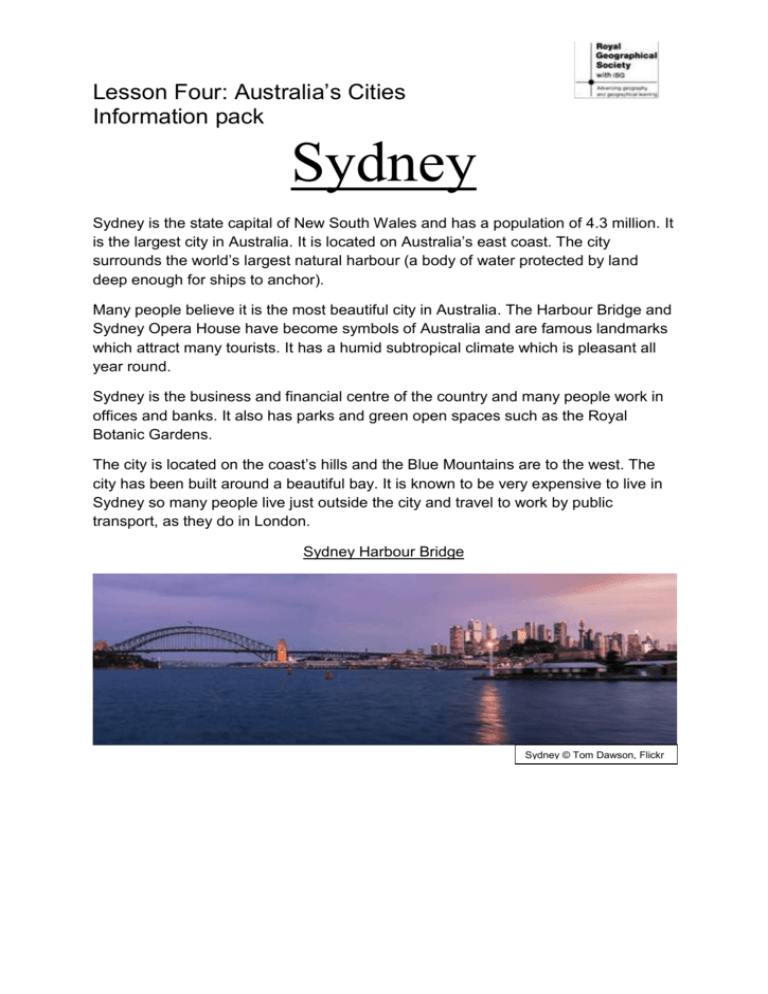
Lesson Four: Australia’s Cities Information pack Sydney Sydney is the state capital of New South Wales and has a population of 4.3 million. It is the largest city in Australia. It is located on Australia’s east coast. The city surrounds the world’s largest natural harbour (a body of water protected by land deep enough for ships to anchor). Many people believe it is the most beautiful city in Australia. The Harbour Bridge and Sydney Opera House have become symbols of Australia and are famous landmarks which attract many tourists. It has a humid subtropical climate which is pleasant all year round. Sydney is the business and financial centre of the country and many people work in offices and banks. It also has parks and green open spaces such as the Royal Botanic Gardens. The city is located on the coast’s hills and the Blue Mountains are to the west. The city has been built around a beautiful bay. It is known to be very expensive to live in Sydney so many people live just outside the city and travel to work by public transport, as they do in London. Sydney Harbour Bridge Sydney © Tom Dawson, Flickr Lesson Four: Australia’s Cities Information pack Sydney © Dr. Andrew Lee The Sydney Opera House Sydney © Corey Leopold, Flickr The location of Sydney Source: Wikipedia Lesson Four: Australia’s Cities Information pack Perth-Fremantle Perth-Fremantle is the capital of the state of Western Australia. Western Australia is large- about 2.5 million sq km! There are deserts, a beautiful coast and excellent surfing. Perth is the most isolated city in the world. It is known for its fine food, great skyline and attractive parks. Western Australia is a home of fabulous Ningaloo reef which some say rivals Great Barrier Reef. Perth is located in a different time zone to Sydney, and time here is three hours behind Sydney. Perth Skyline Perth Skyline © Ole Reidar Johansen, Flickr Perth-Fremantle green space and skyscrapers Lesson Four: Australia’s Cities Information pack Perth’s Panorama © akeii, Flickr Scarborough beach Scarborough Beach © Michael_Spencer , Flickr The location of Perth Source: Wikipedia Lesson Four: Australia’s Cities Information pack Melbourne Melbourne has a population of 3.7 million and is the second largest city in Australia after Sydney. It is the state capital of Victoria. It was selected twice as the world’s most pleasant city to live in as it has low crime rate, good health care, and friendly people. The city is thought to be the Australian capital of culture, sport and fashion. The tennis championship (the Australian Open) is held there, Formula One car races and horse races. Melbourne hosted the Olympic Games in 1956, as well as the 2006 Commonwealth Games. Many people enjoy the fashion shops of Melbourne. Lots of people make jokes about Melbourne’s weather, such as: “If you don’t like Melbourne’s weather, wait half an hour, it will change.” Or “in Melbourne, you can have four seasons in one day”. Another one: “in Melbourne, they build all the theatres and museums simply to hide from the rain”. Melbourne’s weather is not as good as Australia’s other cities. Melbourne has less sunny days than Sydney, but it also receives less rainfall and average temperature is lower in Melbourne. The city is situated on the large Port Phillip Bay and the beaches close to the city are St Kilda beach and Brighton beach. You cannot surf there, because there are no waves, but you can swim. The Melbourne sky line and bay Melbourne © Peter McKay, Flickr Lesson Four: Australia’s Cities Information pack Immigration Museum in Melbourne Melbourne Walk © Alan Lam, Flickr The city park Melbourne © Barbiez, Flickr The location of Melbourne Source: Wikipedia Lesson Four: Australia’s Cities Information pack Brisbane Brisbane has lots of beautiful beaches, the famous Great Barrier Reef, crocodiles and a relaxed culture. Its subtropical climate attracts tourists during winter, however most people find it too hot and humid during summer. Brisbane is the capital of the state of Queensland. It has a population of about 1.7 million and is third largest city in Australia, after Sydney and Melbourne. Brisbane's skyline is very impressive, with many high rise buildings. Locals proudly call their city "Bris Vegas". Most of the major tourist attractions, such as the beaches and theme parks, are located on Gold Coast and not in Brisbane itself. The Gold Coast is known as the Beach Capital of Australia. It is an hour drive from Brisbane and has endless beaches, skyscrapers, sunshine and quite warm ocean water to swim and surf in all year round. The Great Barrier Reef is close to the city of Brisbane and attracts lots of tourists to the city. It is the only living structure visible from space and is 3220 kilometers in length; it is the world’s largest coral reef system. It's probably the best place on Earth for diving and snorkeling. In Tropical North Queensland there are lots of tourist companies offering different ways to explore The Reef - from semi-submersible boats to helicopters. Brisbane River, Bridge and Skyscrapers Brisbane River © Aristocrats-hat, Flickr Lesson Four: Australia’s Cities Information pack A view of Brisbane city centre from Kangaroo Point Brisbane CBD Sepia Tone HDRI Nam Nguyen © Flickr View of Great Barrier Reef Scenic flight over Great Barrier Reef © Sebastian Cruz, Flickr The location of Brisbane Source: Wikipedia Lesson Four: Australia’s Cities Information pack Adelaide Adelaide is the state capital of South Australia. It is famous for its beautiful natural landscapes such as Kangaroo Island and the Flinders Ranges. It is the fifth largest city in the country and has a population of around 1.2 million. The city has a mild Mediterranean climate with a 15° C average daily temperature in winter and a 29° C average over the summer period. It has easy access to the ocean and beaches. There are historic buildings and churches in Adelaide, many green parks and festivals. However, some people believe Adelaide is not the most interesting of Australia’s cities. Adelaide is close to the Barossa Valley (a world-wide known wine region as it is easy to grow grapes in the climate). Cleland Wildlife Park is a great place to see native Australian animals such as Rock Wallabies, Koalas and Kangaroos. There are magnificent physical features on Kangaroo Island, Adelaide. Remarkable rocks are one of the best known attractions and are located in the Flinders Chase National Park. There are also man-made or human features in Adelaide such as the Brighton Jetty. Brighton Jetty in Adelaide IMG_0140-levels © eosdude, Flickr Kangaroo and baby Joey at Cleland Wildlife Park Mum and Joey © eidlog 42, Flickr Lesson Four: Australia’s Cities Information pack Adelaide Port Adelaide © Stephen Beaumont, Flickr River Torrens, Adelaide River Torrens Adelaide © Les Haines, Flickr The location of Adelaide Source: Wikipedia Lesson Four: Australia’s Cities Information pack Darwin Darwin is the capital city of the Northern Territory state of Australia. It has a population of 97,000. It has a population density of only 0.1 person per square kilometre. The town was completely destroyed by Cyclone Tracy in 1974 and had to be totally rebuilt. It is home to over 50 different nationalities. The indigenous population, the Larrakia people are active members of the community. The Larrakia people lived in the greater Darwin region before European settlement in the 1700’s. The didgeridoo, the famous instrument of indigenous Australians, originally came from Arnhem Land, just east of Darwin. Darwin is located on the coast of the Timor Sea and is set on a rocky peninsula that stretches into a beautiful natural harbour on the northern Australia coast. The area surrounding the city has a desert landscape. The Northern Territory is also famous for the Alice Springs and the great "Red Rock", Uluru, and being home to many crocodiles. Darwin has winter-free tropical climate with an average temperate of 30°C. From May to September the days are mild, with gentle winds and blue skies. December to March is the best time to visit this part of the country, as it is greenest and you can see the secluded waterholes, cool waterfalls and billabongs full with exotic wildlife. The coolest months of the year are June and July, when the daily temperature ranges from 19ºC to 30ºC. Darwin at Winter © Alberto…, Flickr Darwin’s Skyline Lesson Four: Australia’s Cities Information pack City landscape of Darwin, Northern Territory © Jeremy De Guzman, Flickr The Central Business District (CBD) of Darwin Source: "Darwin CBD-2005 Wikimedia Commons The location of Darwin City Source: Wikipedia
